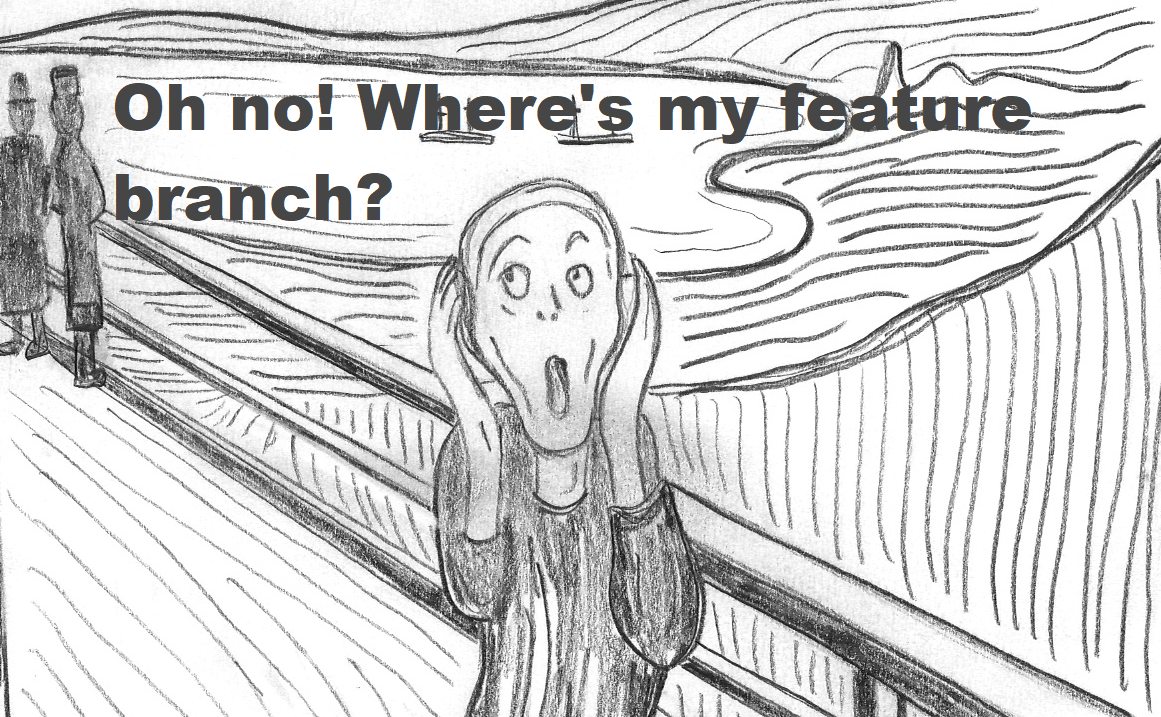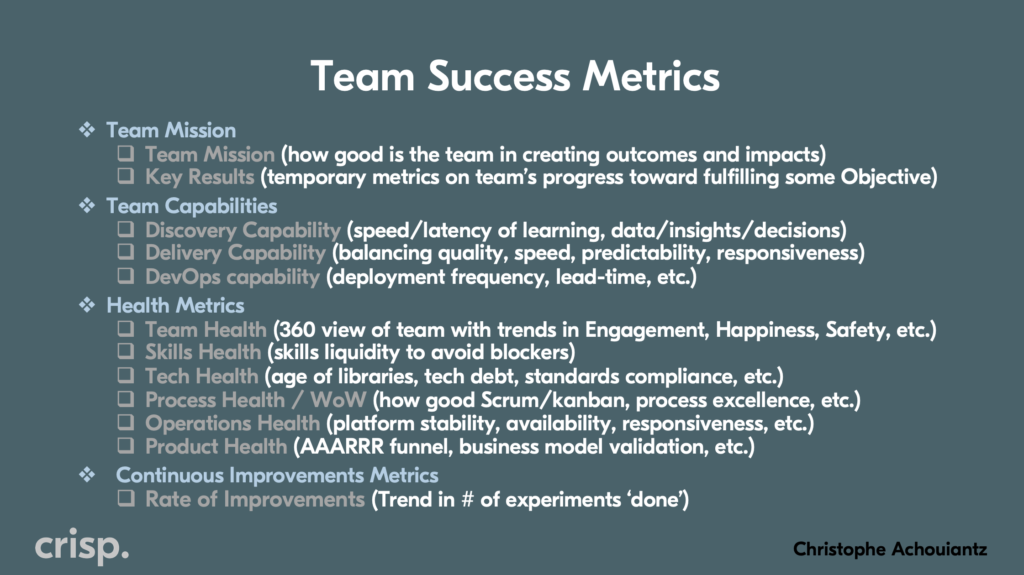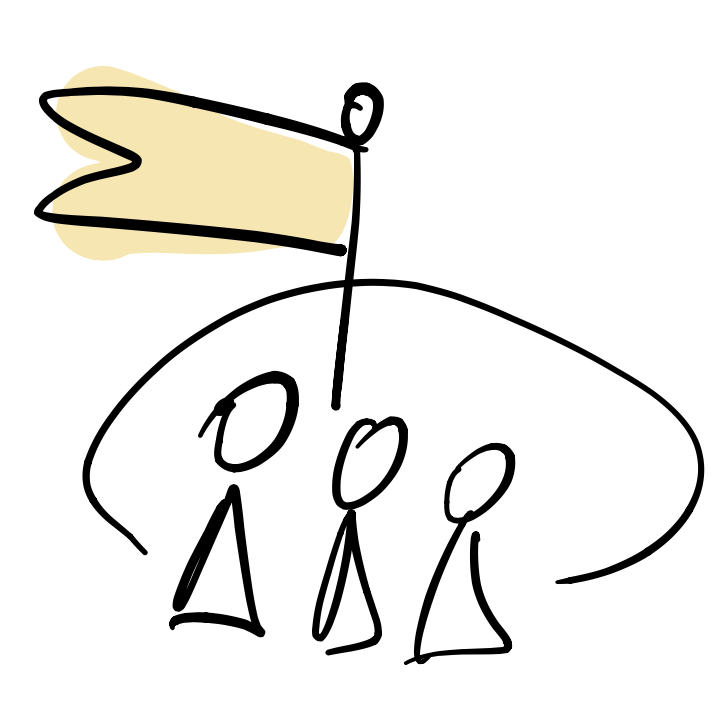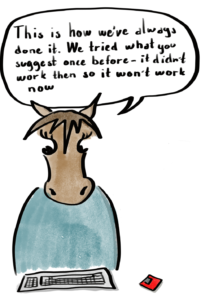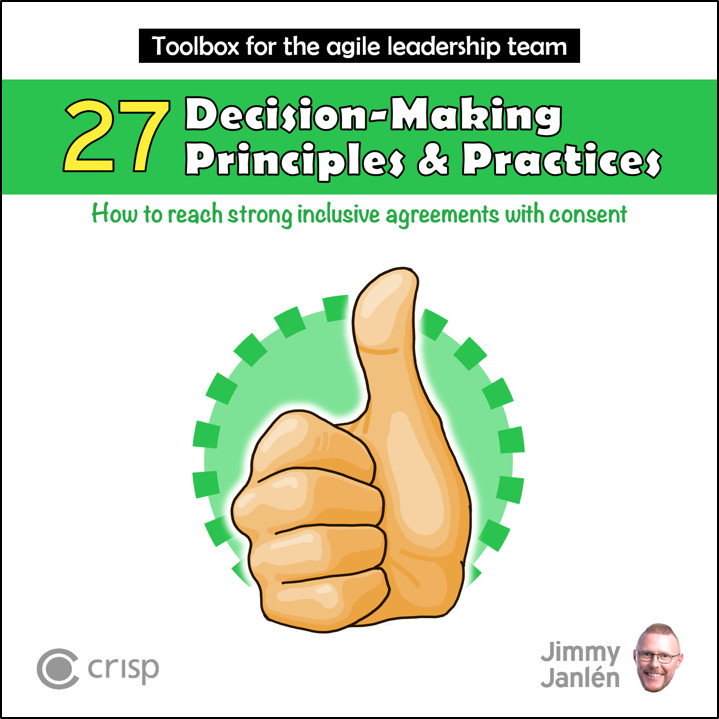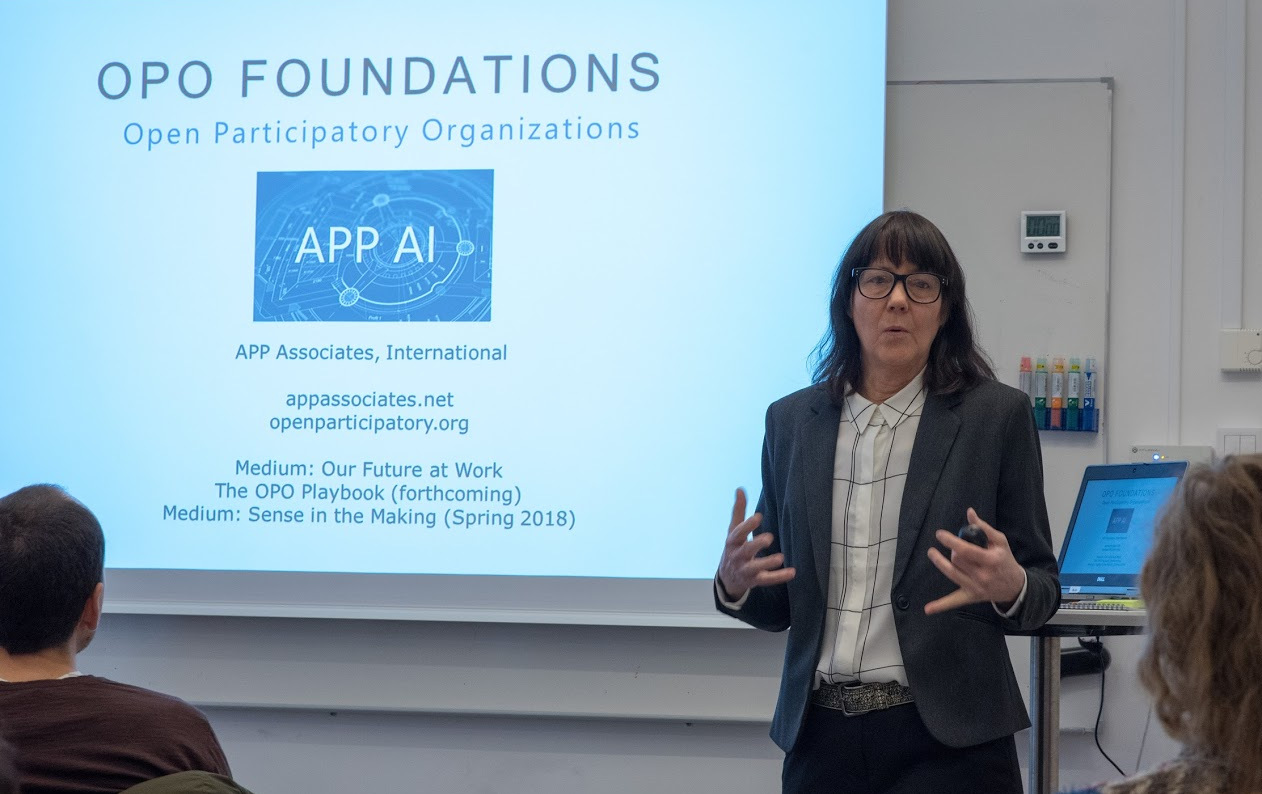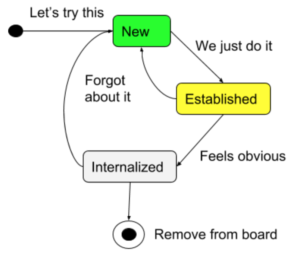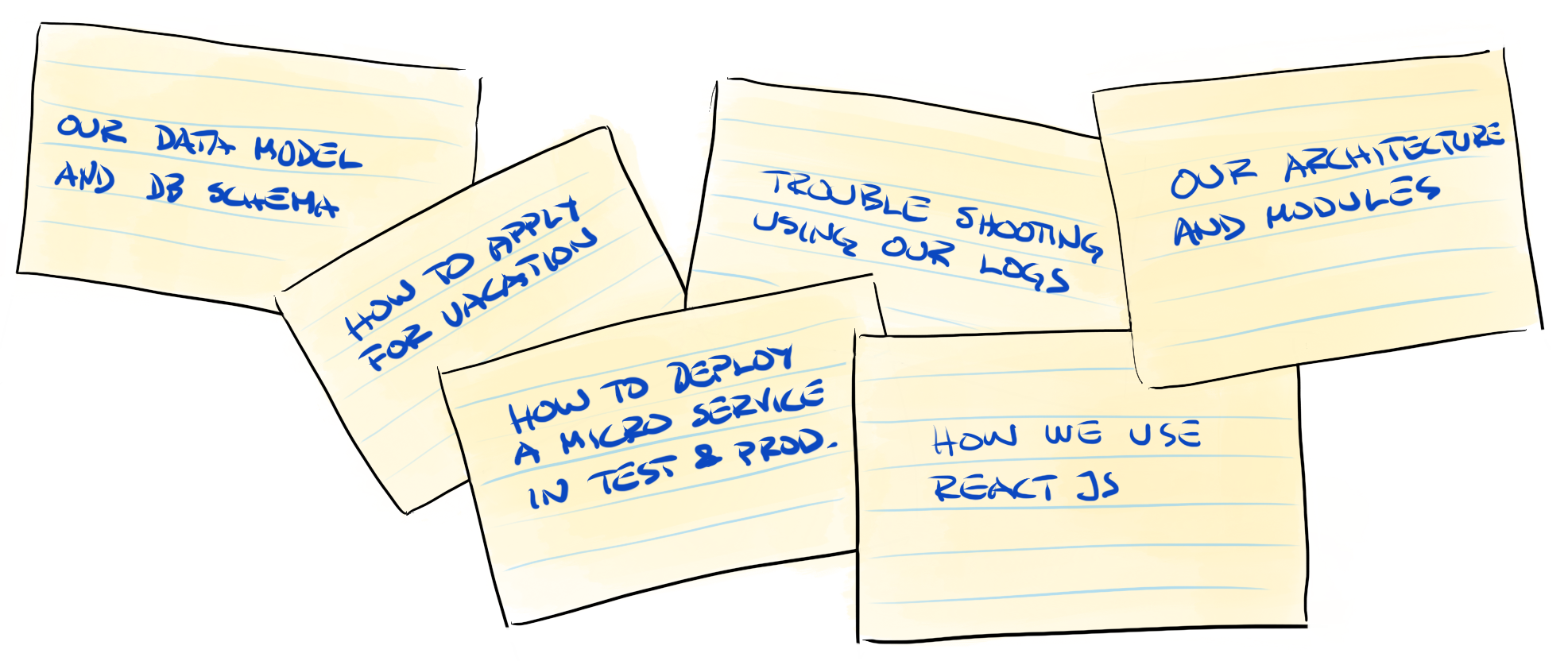What’s the alternative to complex branching and pull requests? Trunk-only development drives practices such as testing, incremental development, and branching by abstraction. It also improves communication within the team.
Continue readingTeam Success Metrics
Are we successful as a Team? Can we measure that? We look at 10+ areas of team success and how to measure them. Get inspired to choose the metric you need, right now, on your path to high-performing!
Continue readingThe Lead-Squad Protocol
How to successfully drive initiatives, objectives or opportunities that require several squads (or teams) to succeed? How to do this in a way that respects the agile mindset without falling into the command-and-control trap? Today, this problem is more complex than it seems. We’ve designed and built our squads for self-organization and autonomy in the
Continue readingA facilitation guide for team start ups and restarts
This guide explains the main ingredients necessary for facilitating a team start up and provides you with six example agendas. The guide includes questions to think about when you set up the facilitation and during the meeting.
The components needed for a team start up

- Purpose or mission -> why does the team exist?
- What is the business value?
- What does success look like?
- Understanding who the team members are:
- Clearly defined membership list -> who is on the team?
- Make sure that people get to know each other -> who are my team members as people?
- What are people’s skill sets? What do they know now, what do they want to get better at?
- Agree to how to work together
- What do team members expect from each other
- What behaviors does the team want to have
- How to talk to each other?
- How to split up work?
- What meetings/sync/feedback is needed
Questions to consider for each area
Continue readingÖvning kring grupputveckling
Mia Pilebro, agil coach på Arbetsförmedlingen, och jag, genomför ett Scrum Master program med deltagare från två av enheterna på arbetsförmedlingens IT-avdelning. Programmet innehåller sex träffar med en tvådagars workshop som inledning, fyra träffar, så kallade Learning Labs, varannan vecka, och till sist en avslutande heldag för gemensam reflektion och sammanfattning av programmet. Under den andra Learning Lab-träffen som vi hade för några veckor sedan jobbade vi kring grupputveckling; hur utvecklas en grupp från det att den bildas initialt tills det att den möjligtvis blivit en högpresterande enhet? Vad är det för mönster som visas i olika faser av gruppens utveckling, dvs vad är det för beteenden vi generellt kan uppmärksamma och hur kan man beskriva vad som tar gruppens fokus och energi? Dessutom tittade vi på hur ledarens agerande behöver förändras utifrån där gruppen befinner sig i sin utvecklingsresa.
Mia och jag organiserar träffarna med korta teorigenomgångar blandat med gruppövningar för att skapa en bra miljö för lärande och utveckling. Vid detta tillfälle skapade vi en kortlek och spelplan utifrån Susan Wheelans forskning kring grupputveckling, hennes modell ”Integration Model of Group Development” (IMGD), som beskriver fem faser en grupp kan utvecklas genom:
- Tillhörighet och trygghet
- Opposition och konflikt
- Tillit och Struktur
- Arbete och produktivitet
- Avslut
Då vi endast fokuserade på de fyra första faserna under vår träff innehåller spelplanen inte den sista avslutande fasen.
Workshopen blev väldigt lyckad med både hög energinivå och ett bra lärande kring ämnet. Jag vill därför beskriva hur vi organiserade delen där gruppen fick arbeta kring grupputveckling med hjälp av kortleken vi skapade, och också dela materialet att använda hos era arbetsplatser. Länk till spelkort och spelplan finns längre ner i denna artikel.
Förutsättningar för en positiv grupputveckling
Jag utbildade mig nyligen till handledare för försvarshögskolans koncept Utvecklande Ledarskap (UL); fem mycket inspirerande och lärorika dagar. Förutom ny kunskap har jag dock också med mig upplevelsen kring kraften i grupputveckling när den blir som bäst. Under kursen satt och jobbade vi i kvarteret där vi både hjälpte varandra förstå kursinnehållet men också förberedde och genomförde en del av den normala UL-kursen inför övriga kursdeltagare. Det är fascinerande hur starkt relationerna inom en grupp kan utvecklas, och från det att en tydlig teameffekt kan växa fram, efter så kort tid som några få dagar.
Det fick mig att fundera på vad det var som hände under kursen som gjorde detta möjligt. Vid reflektionen kring hur utbildningen var strukturerad, den miljö vi befann oss i, handledarnas agerande och vad vi gjorde i kvartetterna, landade jag i att nedanstående fyra aspekter hjälpte oss till att formeras till kraftfullt team under veckan som gick:
- fokus på att bygga en trygg miljö,
- Vi hade väldigt tajta målsättningar att arbeta mot
- Det fanns möjligheten till frekvent feedback på de resultat vi skapade, samt vi gav varandra löpande feedback på varandras prestationer
- och vi var en liten och komplett gruppering som skulle lösa uppdraget tillsammans självständigt.
Anti-Agile Personalities – Part 2
In my previous blog post I listed personalities on the management side that stood in the way of efficient, modern product development. In this post, I will cover some of the personalities you might find in the actual development teams.
Continue readingEfficient, effective and inclusive decision-making – A bold statement, a book and a video
I hereby proclaim that; there are ONLY 10 different ways a decision can be made!
At least in a meeting with several participants.
Sorry for starting with this click baity statement. On the other hand – I haven’t been disproven so far. Regardless of if this is true or not, I believe that the art and skill of decision-making is an increasingly important topic. Why do I believe that?
In many organizations, I often encounter the assumption that a decision is either made by one person, or by a group that has discussed a proposal until everyone agrees. If this is actually true, your ability to conduct effective, efficient and inclusive decision-making is sadly limited. A rapidly increasing number of companies go agile, organizing people into a network of autonomous teams, supported by teams of managers and leaders.
Decision-making and ownership are decentralized to those closest to the problems and opportunities. Leadership is no longer manifested in hierarchies of individual accountability, but in interconnected layers of supportive leadership teams. Just as agile teams collaborate to delivering value to users and customers, so must the leadership collaborate when working, meeting and making decisions. A leadership team’s ability to reach a shared understanding through debates and discussions, explore options and then together decide on the best path forward – is crucial. The speed to decision and time to review and evaluate the impact will dictate your whole organization’s ability to quickly respond, learn, adapt and improve.
With this blog I hope to expand your toolbox and inspire you to experiment with a more varied approach to decision-making.
.
Continue readingAnti-Agile Personalities – Part 1
The technology development is going in lightning speed nowadays and almost every company has at least 10 competitors who can offer their customers the same or better experiences or goods. This puts quite a lot of pressure on companies and organisations to be nimble and customer focused which in turn does the same on the people working for them. Certain traits have become more important in employees than before, whether it is management or development teams, such as trust, flexibility, passion, curiosity, ability to collaborate, humility, and innovativeness. It also means that personalities not defined by these traits that still worked very well in traditional, hierarchical organisations actually might be obstructing efficient development in modern organisations.
Bootstrapping a Working Agreement for the Agile Team
I suspect that running a session with a team to help them bootstrap a Working Agreement, is the single most common workshop I’ve been facilitating the last couple of years. And I’ve learned a lot of what works for me (and what doesn’t work). In my experience, this approach works equally well for the agile team, the department management group and the steering board team. This blog is me documenting how I ended up facilitating these sessions.

For me, a Working Agreement captures the expectations we have on each other within the team when we collaborate and communicate. I’ve seen teams call it “Code of Conduct” or “Ways of Working”. I call it Working Agreement. You call it whatever makes sense for you.
Running a Working Agreement workshop as early as possible is crucial for setting the team up for success. Preferably it’s done during the team’s two-day kick-off offsite, or at least within the first few weeks as a planned structured workshop.
Flow through Visualization – Video från SAST Stockholm
Den 20:e September presenterade jag på SAST Stockholm (Swedish Association for Software Testing). Under 30 minuter delade jag med mig av mina tankar kring hur man uppnår “Flow through Visualization”. Presentationen hittar du här, och nedan har du inspelningen av presentationen. Videon fokuserar bara på mig, men med lite skicklighet kanske det går att klicka
Continue readingQ & A with Bonnitta Roy on Open Participation
Bonnitta Roy was one of the keynote speakers at last year’s Agile People Sweden conference and she also held a course here at Crisp last February on self-organization beyond the team using Open Participatory Organizations (OPO), which was very well received by our course attendants. She is coming back to Stockholm in November and we got the opportunity to sit down with her and ask some questions about open participation and her work on the future of organizational life.
What is open participation and why does it matter in organizational life today?
Organizations face continuous pressure to “level up” to new social and economic realities. This places enormous strain on legacy structures which are difficult to overhaul, and conventional management practices which are difficult to shed. Instead of offering yet another “off-the-shelf” product, we help people see simple but powerful opportunities to become more open and more participatory in their everyday ordinary work.
In agile software development there is the notion of refactoring when code has become too unruly and is increasingly built up in an ad hoc manner. Refactoring means starting over with clean, elegant code. It releases a tremendous amount of complexity from the system. Open participatory practices do the same for organizational structures. It releases complexity and affords more elegant ways to solve complex problems.
So OPO is basically a location based structure to self-organize and to self-manage in organizations?
Self-organization and self-management are core principles of open participation. Location-based-structure is one way to optimize them. It is the only way I know that also avoids the “law of suboptimization” which states that when you optimize the lower system, you suboptimize the higher (and vice-versa). This “law” leads to paradoxes in incentive systems that have to juggle rewarding individual merit, team performance, and company profits.
Locations are defined as mutually interdependent. No individual location can be defined outside of its context with larger strategic wholes; but the “whole” is not defined other than by the interdependent coherence of all the locations. The language of “location” helps reinforce the synergistic way of thinking. If you renovate your kitchen you are simultaneously adding value to your house, and to the experience of everyone who lives there. Similarly, in the OPO, people focus on making sure that the locations are healthy, and that the relationships between them are synergistic. This simultaneously adds value to the larger whole.
Let’s ask some frequently asked questions, as most readers may be new to these ideas.
The three states of working agreements
You may have read about this elsewhere, but a recent event led me to write this. I feel that the working agreements concept is not given the attention it deserves. Working agreements are about making your culture explicit. It is desirable to have them visualised on your Scrum board as a constant reminder. Question is, when do we remove them from the board so that they don’t cover the whole board? My answer is, when the third state is reached, “internalised”.
Core Protocols – effective communication
– Having rules for communication is stupid!
– What was your intention with calling the rules stupid?
– Well, I’m sorry, I didn’t mean anything negative towards you, of course. I just don’t find such rules necessary at all. We have been communicating with each other since we were small.
– Okay, I understand what you are saying. But, hear me out…
UX – It’s obvious, right?: Part 3
In the talk I gave at Agila Sverige in June, I brought up misconceptions about UX I’ve encountered during my years in the IT business. One of these is that it’s only the UX people (and possibly the PO) who need to meet the users. In this post I’ll discuss why this not true, but also how meeting the users can make a real difference in focus and motivation for the team.
New Jimmy Cards in the making – Blue and Black Deck
Note: Access to Google Docs and Feedback has been disabled.
Back in 2013 I created a deck of cards with questions for the agile team, called “Jimmy Cards”. The questions on the cards were designed to ignite exciting discussion for teams to get to know each other and grow as a team.
I’ve received so much great feedback and appreciation over the years since. This feedback inspired me to create two more decks, the Black Deck and the Blue Deck. The Black Deck is for mature agile teams. The Blue Deck for leadership teams.
These have been in the working for over a year now but now I feel it’s time I wrap up my work and print them. I’m however not confident on the level of quality just yet, so this blog is a plead for help.
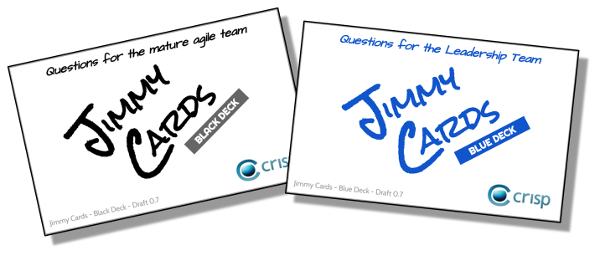
The Training Deck – how to onboard a new team member faster
There will always be a productivity dip for the team when a new member joins. The question is not if it is going to happen, but how much will productivity dip and for how long. Imagine if you could onboard new team members with a minimum of productivity loss.
Team Shapes – Simulating the challenges with component teams
A common pitfall for large and medium size organizations who are adopting Agile is to organize teams based on software component boundaries instead of feature teams. Some of the aspects of long term code ownership are more straightforward this way, but the negative consequences in terms of business agility and costs of coordination are huge. A few years back I designed a simulation exercise that I call Team Shapes which illustrates some of the issues and now I would like to share this simulation with the community.Continue reading
4+3+2+1 Team Success Factors
I’ve now published a new YouTube video where I present 4+3+2+1 Team Success Factors, a model that captures and describes what you can do to help make your team become strong and successful. These 10 factors are split into four groups. * The first group describes four dialogs we need to have as a team. * Next
Continue readingTransforming the pyramid to an agile org
I recently published a video exploring how an agile team based organization could look like. How does it function under the hood? In the video I also discussed how you get there.
I got tons of great feedback so I decided to provide the contents of the video in the format of a blog. If you prefer to read instead of watching a 11-minute-long video, then this is for you 🙂
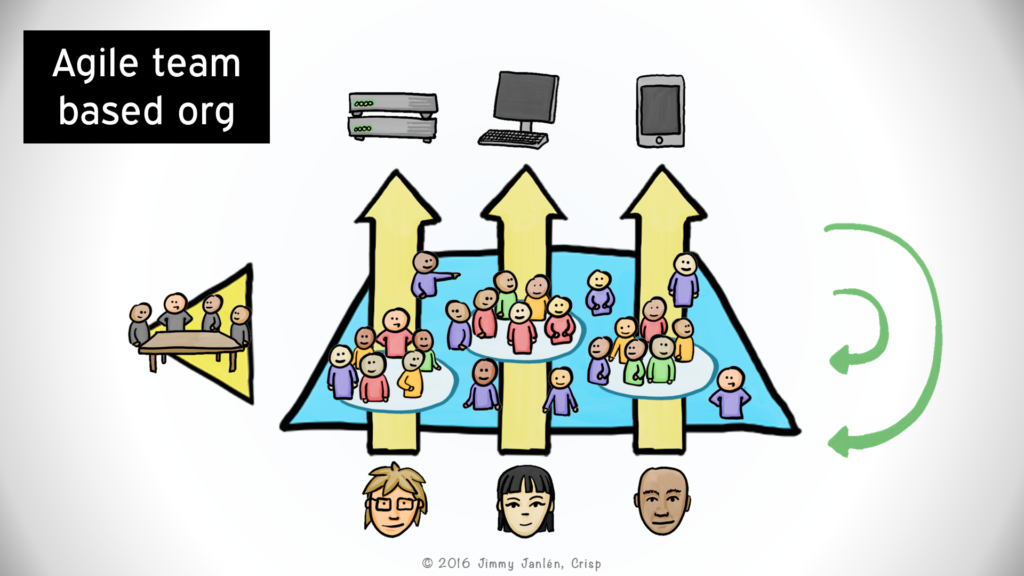
Scientific method applied to performance improvements
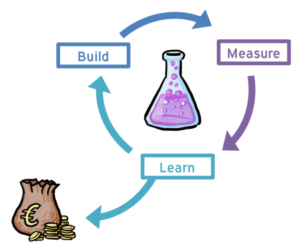 In my team, we are working on improving real-time performance for our main service. The goal is to have response times below 100 ms in the 95th percentile and below 200 ms in the 99th percentile for certain database volumes and request frequencies.
In my team, we are working on improving real-time performance for our main service. The goal is to have response times below 100 ms in the 95th percentile and below 200 ms in the 99th percentile for certain database volumes and request frequencies.
We don’t know what will be needed to reach this goal. We have some ideas, but we don’t know which one, or which ones will do the trick. We call these ideas “experiments”.
We can estimate each experiment, but we don’t know how many we will need to do to reach the goal.
This is the story of how we apply the scientific method to working with performance improvements.
X-team Silos Game – getting in T-shape
Cross functional teams are complete in expertise but not necessarily collaborative. Sometimes team members hold on to their expertise too much and the team does not perform to its potential. This Lego game illuminates the difference when members allow themselves to take on tasks outside their expertise, being so called T-shaped. Play the game to kick-start your change and create collaboration.
Better meetings with the Core Protocols

Good meetings is very much about achieving deep collaboration. But collaboration is often hard. We go into meetings with different modes, intentions, and expectations. How can we make meetings both more fun and energetic? Surprisingly enough: maybe by being more formalized.
Continue reading
The importance of size and proximity
We have translated our blog on team size and proximity to english. If you prefer to read it in Swedish it’s called Storlek och närhet har betydelse. The english version you’ll find at Nomad8 site, because Jimmy Janlén is currently in New Zealand. 🙂
Continue readingStorlek och närhet har betydelse
Process är dyrt. Större team, distansarbete, deltidsarbete samt många specialister leder till mer uppstyrd process. Kanske är detta självklart, men ju fler företag vi lär känna, desto mer upplever vi detta vara något som ignoreras.
Jobbar vi i någon form av agil process såsom Scrum, Kanban, eller Lean UX värderar vi högt samarbetet mellan olika kompetenser. Ett team av olika kompetenser som kan ta en idé från start till mål brukar kallas tvärfunktionellt.
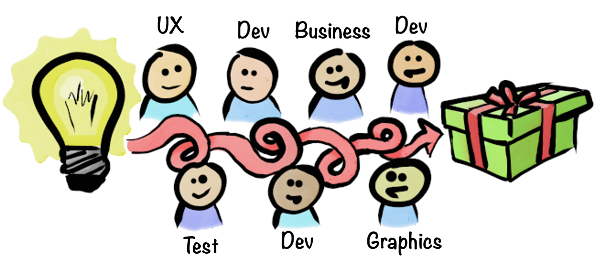
Enklast möjliga agila process för hur dessa personer kan samarbeta ser ut så här:
Continue reading
Fluent@agile – visualizing your way of working
Help your team improve by visualizing their way working with the fluent@agile game. With the game you can help a team find out where it is on its agile journey and help it find new ways of both fine tuning and make leaps in their daily agile practices.
Me and Christian Vikström made the game together at Spotify during the spring 2014 when we were coaching and helping team to improve their agile skill sets and processes.
At Spotify the teams owns their own way of working. A team is basically only accountable to itself. We therefore needed an coaching tool that could help team take ownership of their self image and improvement strategy.
We also wanted the tool to be opinionated. It should be normative, tell what’s good and not, what kind of practices and behaviour that’s expected and not. But at the same time it should be open to new ideas, new practices and the teams local conditions.
Continue reading
New book: Toolbox for the Agile Coach – Visualization Examples, now available on LeanPub!
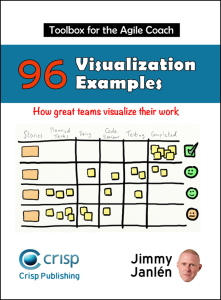 I’m happy to announce that Toolbox for the Agile Coach – Visualization Examples is now available on LeanPub! It’s a 124 page book cramped with visualization examples for teams on how to improve collaboration and communication, as well as shaping behaviours.
I’m happy to announce that Toolbox for the Agile Coach – Visualization Examples is now available on LeanPub! It’s a 124 page book cramped with visualization examples for teams on how to improve collaboration and communication, as well as shaping behaviours.
It’s been great fun to write. It’s been great fun to get feedback from early readers. It’s been great fun to show it to colleagues and friends. And now, finally, it feels awesome to be able to share it with you!
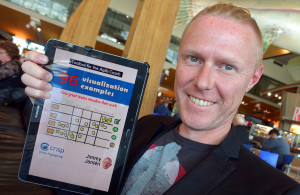 I planned to release the book in physical and digital form at the same time… but getting it printed have sadly taken forever, and I still don’t know when it will be available on Amazon.
I planned to release the book in physical and digital form at the same time… but getting it printed have sadly taken forever, and I still don’t know when it will be available on Amazon.
So, I’ve decided to go ahead and release the digital version first. Might be a stupid thing to do from a marketing perspective, but I don’t care about that. I want the book out and available 🙂
Scaling Agile (but not in the way you think…)
For more than a year now, I’ve been working with clients that have agile scaling problems. But not the kind of scaling problem everybody is talking about – one product and lots of teams. No, I’ve been busy trying to sort out what to do when you have one team supporting a multitude of products with different architectures, stakeholders, technology stacks and whatnot. This is what I’ve learnt, so far.
Slides från session Agila Arbetsmetoder @ SAST Q20
Otroligt kul att se hur många som fick plats i ett konceptrum i Aula Magna under våra presentationer under SAST Q20! Vi pratade först om kontinuerlig förbättring och sedan om working agreements. Slides hittar du nedan. Kontinuerlig förbättring Working Agreements På Crisp har vi en hel del gratis material och guider, bland annat en Toyota
Continue readingAgile Topics card deck
The other week I got the idea to create simple conversation cards. Each card represents an agile practice, a conversation topic or an abstract theory. Now I’ve drawn 96 cards. I simply couldn’t stop 🙂
